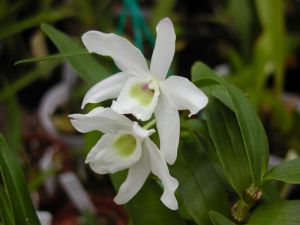
Common Name: The Noble Dendrobium
Scented: yes
Light Requirements: partial sun
Temperature Requirements: cold to intermediate
Blooms: mostly winter and spring
Flower Size: to 7.5cm
Synonyms: Callista nobilis (Lindl.) Kuntze 1891; Dendrobium coerulescens Wallich 1838; Dendrobium formosanum [Rchb.f]Masamune 1933; Dendrobium lindleyanum Griffith 1851; Dendrobium nobile f. nobilius (Rchb.f.) M.Hiroe 1971; Dendrobium nobile var. alboluteum Huyen & Aver. 1989; Dendrobium nobile var. formosanum Rchb.f. 1883; Dendrobium nobile var. nobilius Rchb.f. 1833
This is a medium sized, cold to warm growing terrestrial or lithophytic species from the Chinese Himalayas, Assam, eastern Himalayas, India, Nepal, Bhutan, Sikkim, Myanmar, Thailand, Laos and Vietnam that is found in broadleaf, evergreen, lowland forests and primary montane forests as well as on mossy limestone rocks at elevations of 200m to 2000m with erect, clustered, compressed, grooved with age, yellowish stems carrying distichous, coriaceous, strap-shaped, or oblong, persistent leaves that blooms mostly in the winter and spring but is possible throughout the year on short, 2 to 4 flowered racemes with fragrant, waxy, heavy-textured,long-lived, highly variable [mostly color] flowers that arise at the upper nodes of leafed and leafless canes. They need a decided winter rest from fertilizer and water to ensure a good bloom season and the yellowing of the leaves in the fall is the sign to begin.